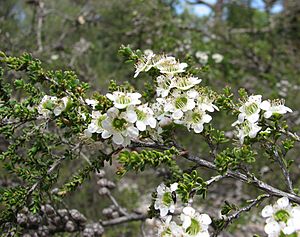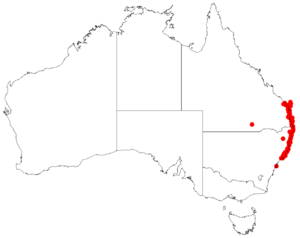Olive tea-tree facts for kids
Quick facts for kids Olive tea-tree |
|
|---|---|
 |
|
| Leptospermum liversidgei in Maranoa Gardens | |
| Scientific classification | |
| Genus: |
Leptospermum
|
| Species: |
liversidgei
|
 |
|
| Occurrence data from AVH | |
| Synonyms | |
|
|
The Leptospermum liversidgei, often called the olive tea-tree, is a type of compact shrub. It is found only in eastern Australia. This plant has narrow, egg-shaped leaves that smell like lemon. It produces white or pink flowers and woody fruits that stay on the plant even when they are ripe.
Contents
About the Olive Tea-Tree
The olive tea-tree is a shrub that can grow up to 4 meters tall. Its main branches have thin, rough bark, and its younger stems are a bit fuzzy. The leaves grow close together and are narrow and egg-shaped. They have a fresh lemon scent. Most leaves are about 5-7 millimeters long and 1-2 millimeters wide. They grow on a very short stem called a petiole.
The flowers of the olive tea-tree are either white or pink. They are about 10-12 millimeters wide and grow on a short stalk, called a pedicel, which is about 1-1.5 millimeters long. Each flower grows by itself at the end of short, bare side branches. The base of the flower, called the floral cup, is dark and about 2.5 millimeters long. The sepals, which are like small leaves protecting the bud, are about 2 millimeters long. The petals are about 5 millimeters long, and the stamens, which produce pollen, are 1.5-2.5 millimeters long.
This plant usually flowers in January. After the flowers, it grows a woody fruit. This fruit is a capsule about 7-10 millimeters wide. What's interesting is that these fruits do not fall off the plant when they are mature.
Naming the Olive Tea-Tree
The Leptospermum liversidgei was first officially described in 1905. Two scientists, Richard Thomas Baker and Henry George Smith, gave it its scientific name. They published their findings in a science journal called the Journal and Proceedings of the Royal Society of New South Wales.
The second part of its scientific name, liversidgei, was chosen to honor a person named Archibald Liversidge.
Where the Olive Tea-Tree Grows
The olive tea-tree is found in coastal swamps. You can see it growing in areas between the Bundaberg region in Queensland and Tomago in New South Wales. It prefers to grow in a type of open shrubland called heath.
Growing the Olive Tea-Tree
Because of its size, the olive tea-tree is a good choice for smaller gardens. It can handle soil that doesn't drain very well and can also survive at least moderate frost. The leaves of this tea-tree contain a special oil called citronellal. Some people believe that this plant can help keep mosquitoes away because of this oil.
- Harden, G.J., Flora of New South Wales, Volume 2, ISBN: 0-86840-164-1.
See also
 In Spanish: Leptospermum liversidgei para niños
In Spanish: Leptospermum liversidgei para niños

